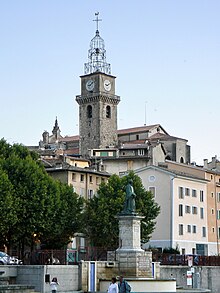Digne-les-Bains
| Digne-les-Bains | ||
|---|---|---|

|
|
|
| region | Provence-Alpes-Cote d'Azur | |
| Department | Alpes-de-Haute-Provence | |
| Arrondissement |
Digne-les-Bains ( Prefecture ) |
|
| Canton |
Digne-les-Bains-1 Digne-les-Bains-2 |
|
| Community association | Provence-Alpes agglomeration | |
| Coordinates | 44 ° 6 ' N , 6 ° 14' E | |
| height | 524-1,731 m | |
| surface | 117.07 km 2 | |
| Residents | 16,460 (January 1, 2017) | |
| Population density | 141 inhabitants / km 2 | |
| Post Code | 04000 | |
| INSEE code | 04070 | |
| Website | Digne-le-Bains | |
 Digne-les-Bains and the Pre-Alps |
||
Digne-les-Bains (until 1988 only Digne ; Occitan Dinha ) is a town in the south of France and a municipality with 16,460 inhabitants (as of January 1, 2017). It is the main town ( Prefecture ) of the departments of Alpes-de-Haute-Provence in the region Provence-Alpes-Cote d'Azur . Digne-les-Bains is a spa town (les Bains) and is also known as the "capital of lavender ". The municipality is considered the access point to the Verdon Regional Nature Park .
The city is the seat of the diocese of Digne , which has existed since the 4th century. Episcopal church is the Saint-Jérome cathedral .
Location and climate
Digne-les-Bains, embedded in an attractive landscape in a low mountain range , extends in a wide basin to the left and right of the Bléone , which flows further west into the Durance . The city is located on the Route Napoléon about halfway between Grenoble (approx. 180 km northwest) and Cannes (approx. 135 km southeast) at an altitude of approx. 600 m . The climate is temperate to warm; Rain falls mainly in the winter months.
Population development
| year | 1806 | 1851 | 1901 | 1954 | 1999 | 2017 | ||
| Residents | 3,362 | 4,781 | 7,238 | 10,436 | 16,064 | 16,460 | ||
| Source: Cassini and INSEE | ||||||||
Digne benefited in the 19th and 20th century by the mechanization of agriculture farming and the abandonment small businesses caused rural exodus .
economy
In earlier centuries the residents lived on the yields of their fields and gardens as self-sufficient ; viticulture and cattle breeding were also practiced. Since the middle of the 19th century, spa tourism has contributed significantly to the upswing of the place.
history
Small prehistoric finds have been made in the vicinity of the city. The Romans called the place Dinia and valued it for its thermal springs . In the Middle Ages, the place was divided into two parts between a castle district (bourg) and the actual settlement (cité) . Around the middle of the 13th century there was a division of power (paréage) between episcopal and counts' power. In the middle of the 15th century the plague was rampant ; towards the end of the century there were pogroms against the Jews . In the Wars of Religion (1562-1598), the cathedral was largely destroyed. Another epidemic in the years 1629–1631 led to a profound decline in population. In 1815 Napoleon passed through the city after fleeing Elba.
Attractions
See also: List of Monuments historiques in Digne-les-Bains
- Old town
- Cathédrale Saint-Jérôme
- Cathédrale Notre-Dame-du-Bourg
- Ammonite rocks on the Barles road (Valley des Bès) (Réserve naturelle géologique de Haute-Provence)
- Historic fountain in Bourg
- Cordeliers Garden (Jardin des Cordeliers)
- Monument to Pierre Gassendi
- Lourdes chapel above the city (Notre-Dame-de-Lourdes)
- St. Vincent Chapel above the town (La chapelle Saint-Vincent)
- Kreuzkapelle above the town (La chapelle de la Croix)
traffic
The meter- gauge narrow - gauge railway Chemins de fer de Provence (CP) runs between Digne-les-Bains and Nice . The regular-gauge railway line to Château-Arnoux-Saint-Auban of the SNCF was closed in 1989.
Sports
Digne was a stage destination of the Tour de France in 2005 and 2008 . In 2015 the 17th stage to Pra-Loup started there.
Town twinning
- Bad Mergentheim , Baden-Württemberg , Germany , since 1962
- Borgomanero , Piedmont , Italy , since 2000
- Douma , Lebanon
- Kamaishi , Japan
Personalities
sons and daughters of the town
- Paul-Alexandre Arnoux (1884–1973), writer
- Alphonse Beau de Rochas (1815–1893), railway engineer and inventor
- Alain Boghossian (* 1970), national soccer player
- Jean Daviot (* 1962), video artist
- Tristan Louis (* 1971), publicist
- Louis Richeome SJ (1544-1625), Christian humanist
- Jean Rolland (1935–1967), racing car driver
- Gabrielle Traxler (1942–2015), Austrian politician ( SPÖ )
People related to the city
- Alexandra David-Néel (1868–1969), travel writer and Buddhist nun, died in Digne
- Pierre Gassendi (1592–1655), worked around 1608 as a rhetoric teacher in Digne
Others
- Victor Hugo's famous novel The Misery ( Les Misérables , 1862) begins in Digne.
- The "Affaire Dominici", a famous 1952 murder filmed with Jean Gabin in 1973 , took place near the city; the trial of the alleged murderer Gaston Dominici took place in Digne.
- In the early 1980s, Europe's largest ammonite field was discovered during road construction work. It is an exposed plate of 350 square meters on which experts counted 1,500 petrified molluscs that are over 200 million years old. Furthermore, in the "Réserve Naturelle Géologique de Haute Provence", a 145,000 hectare nature reserve, petrified plants and a 185 million year old ichthyosaur can be seen on marked paths . Also in the Musée Promenade , a villa decorated with frescoes, which was set up after the discovery of the ammonite slab , one can study and follow the development of the early geological history.
- On July 28, 1999, the asteroid (10088) Digne was named after the city.



